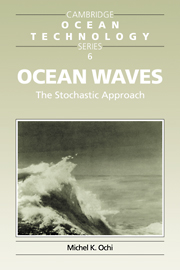Book contents
- Frontmatter
- Contents
- Preface
- 1 Description of random seas
- 2 Spectral analysis
- 3 Wave amplitude and height
- 4 Wave height and associated period
- 5 Sea severity
- 6 Estimation of extreme wave height and sea state
- 7 Directional characteristics of random seas
- 8 Special wave events
- 9 Non-Gaussian waves (waves in finite water depth)
- Appendix A Fundamentals of probability theory
- Appendix B Fundamentals of stochastic process theory
- Appendix C Fourier transform and Hilbert transform
- References
- Index
3 - Wave amplitude and height
Published online by Cambridge University Press: 15 October 2009
- Frontmatter
- Contents
- Preface
- 1 Description of random seas
- 2 Spectral analysis
- 3 Wave amplitude and height
- 4 Wave height and associated period
- 5 Sea severity
- 6 Estimation of extreme wave height and sea state
- 7 Directional characteristics of random seas
- 8 Special wave events
- 9 Non-Gaussian waves (waves in finite water depth)
- Appendix A Fundamentals of probability theory
- Appendix B Fundamentals of stochastic process theory
- Appendix C Fourier transform and Hilbert transform
- References
- Index
Summary
INTRODUCTION
In this chapter, the stochastic properties and probability distributions applicable to wave amplitude and height will be presented under various conditions.
First, the underlying assumptions considered throughout this chapter are that random waves are considered to be weakly steady-state, ergodic, and a normal (Gaussian) random process. The normal process assumption is valid only for waves in deep water. Waves in finite water depths are commonly treated as nonlinear, and considered to be a non-Gaussian random process, as will be discussed in detail in Chapter 9. With these basic assumptions, probability distribution functions which represent the statistical characteristics of random waves are analytically derived.
The most commonly considered probability distribution for wave amplitude is developed assuming that the wave spectrum is narrow-banded. The wave profile under this condition is slowly changing with constant period, and there exists a single peak or trough during each half-cycle. Waves generated by moderate wind speeds, an example of which is shown in Figure 3.1(a), demonstrate that the narrow-banded spectrum assumption is generally acceptable. In this case, wave amplitude follows the Rayleigh probability law as will be presented in Section 3.2. The Rayleigh probability distribution is most commonly considered for the design of marine system.
- Type
- Chapter
- Information
- Ocean WavesThe Stochastic Approach, pp. 58 - 102Publisher: Cambridge University PressPrint publication year: 1998

